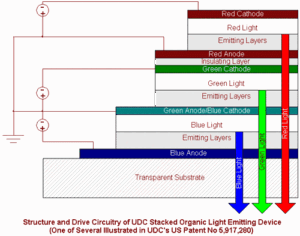The Universal Display Corporation (UDC) is one of the most prominent developers of Organic Light Emitting Devices (OLEDs). Working with researchers at Princeton University and the University of Southern California, it has produced several variations of the OLED designed to help it achieve its goal of developing multi-purpose flat screen monitors which can be wall, or window, mounted. The company’s technology is based on “small-molecule” OLEDs, in which the layers of the display are built up using vacuum deposition. It claims brightness levels of over 100,000 cd/m² and a lifetime of over 10,000 hours at 100 cd/m².
Using transparent electrodes, and light emitting materials that are transparent to the light they produce, as well as most of the rest of the visible spectrum, the company has produced a device it calls a stacked OLED or SOLED. This consists of red, green and blue “TOLED”s (Transparent OLEDs), in which each of the elements is individually controlled. By adjusting the ratio of the current fed to each of the three elements, the colour of each pixel can be varied, while varying the total current through the stack adjusts the pixel brightness and altering the amount of time each pixel is switched on gives greyscale control. This provides the possibility of producing full colour output from each pixel in the display, trebling the potential resolution of the display compared with systems which use RGB pixel triads.
Another variation on the UDC TOLED is the flexible OLED (FOLED). By using a variety of substrates such as optically-clear plastic films and reflective metal foils, the FOLED opens up the possibility of displays that can rolled up or applied to curved surfaces, such as car or aircraft windscreens and helmet visors.
UDC admits that it still has a long way to go before it can commercialise its displays but the opening of a “Technology Transfer and Pilot Line” in December 1999 was a significant step in the right direction.

